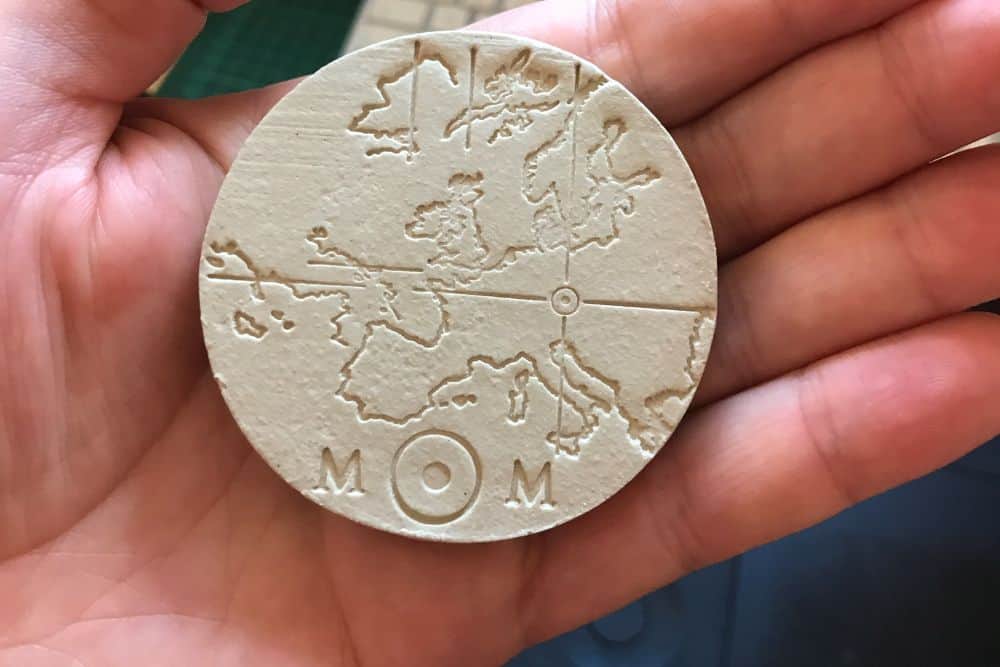
[Image above] An example of the ceramic tokens that will contain a map to the Memory of Mankind archive. Credit: Memory of Mankind
By Laurel Sheppard
We’ve all heard of time capsules, where artifacts from the current era are placed in a container and buried for someone to find years later. In fact, such a time capsule, buried for 118 years, was recently found in an Ohio fire station.
Once hundreds or thousands of years have passed, however, the chances that the artifacts survived become less and less likely. That is because materials, no matter how well preserved, will eventually degrade. However, different materials degrade on vastly different timescales, which is why there are many examples of thousands-year-old pottery pieces but few examples of thousands-year-old animal skins.
To preserve information for long periods, then, you must carefully consider the material being used to store it. Martin Kunze, a ceramicist from Austria, has considered this question carefully. His solution—ceramic tablets—is being put to the test with the Memory of Mankind (MOM) project, which aims to preserve today’s knowledge for people living a million years in the future.
Kunze first experimented with long-term information storage when he was 13. He wrote his name, number, and address on a piece of paper; put it in a bottle; and buried it in the sand. His hopes of a beautiful girl finding his bottle didn’t materialize; instead, a local retiree found the bottle several decades later and contacted Kunze’s parents at the same address.
Later, the book The World Without Us inspired Kunze to think of preserving information on a much grander scale. He believed that much of the digital data residing in the cloud would have to be deleted as space runs out. So, in 2012, he began the MOM project by making a ceramic tablet engraved with a greeting, intended for people to find a million years in the future. Since then, hundreds of tablets have been made, with participants submitting files and e-mails containing different types of information through the MOM website.
In a 2018 GQ article, Kunze described the project as the “first bottom-up history of the world.” The information he is collecting is divided into three types:
- Editorials, mainly from major newspapers;
- Institutional pieces, such as scientific papers, art, popular songs—perhaps Message in a Bottle!—and
- Personal, or anything contributed by individuals about their lives.
Kunze is also asking for help to select the 1,000 most important books of all time. Additionally, the MOM project will document the effects of climate change and locations where nuclear waste is stored. The MOM project has a scientific advisory board as well to help guide the content that is collected.
To store all these text and images, Kunze developed several technologies that are described on the MOM website and elsewhere.
- Special ceramic colors or stains that are used to print photographs and illustrations with 300 dpi resolution.
- A ceramic microfilm that is used for texts and monocolored graphics with a black and white contrast.
Text is downsized (five lines per mm) but is easily read with a 10x magnifier. A tablet that is 8 x 8 inches (20 × 20 cm) can carry up to five million characters, which equals about five 400-page books. Compared to the printed version, a book on microfilm requires 1/200 of the volume.
The digital file is laser engraved directly onto the tablet. A glaze that is alkali, acid, and temperature resistant (up to 1,300°C) is then applied with a roller to improve the tablet’s durability. A deciphering tool consisting of information about current languages (e.g., thesauruses, dictionaries, grammar books, orthographies) and thousands of labeled images will be included to help translate the MOM content. The ceramic tablets are stored in ceramic boxes when placed in the archive.
The MOM archive will be located 2 kilometers deep inside one of the oldest known salt mines, which has been in operation for 7,000 years beneath Mount Plassen in Hallstatt, Austria. In the GQ article, Kunze explains that the mouth to the cavern would naturally close slowly over time, at about the rate a fingernail grows, until it was entirely sealed. At this rate, he would have about 40 years to complete the project.
To help find the MOM archive in the future, Kunze created small tokens (made from ceramic fired at 1,200°C) containing maps to the location. These tokens are handed out to anyone who wants them and will also be buried in strategic locations around the world. Other tokens will be given to 50 people who will be responsible for passing them down to future generations.
Every 50 years, starting in 2070, all holders of a token will get together to consider if the content of the MOM archive should be expanded. By then, there may be new ways to store the information—Kunze is working with scientists to develop new data storage materials that can fit even more information in a smaller area.
As Kunze said in a TEDx talk, “…we need the past to understand the present.” He encourages everyone to “send your personal message in a bottle to the future” by participating in the MOM project. Whoever finds the archives, whether it is a human or some other lifeform, will hopefully have a better understanding of today’s world.
